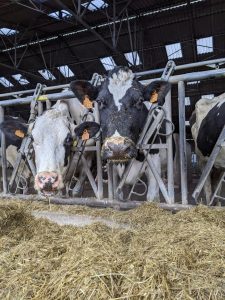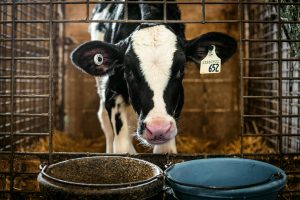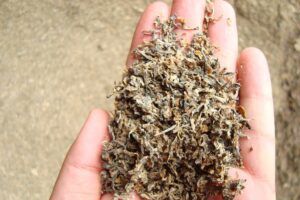Álvaro García
While high-quality forages and grains supply many essential vitamins, commercial supplements are necessary to fill nutritional gaps, especially in high-producing cattle. Evaluating vitamin supplements involves assessing their bioavailability, formulation, and quality. Although rumen microbes can synthesize certain B-vitamins, others—like Vitamins A, D, and E—must be provided through the diet. Vitamin A supports bone growth, skin integrity, and reproductive performance, while Vitamin D regulates calcium and phosphorus metabolism, essential for bone health and muscle function. Vitamin E, a potent antioxidant, protects cells from oxidative damage and strengthens immune defenses, particularly in high-producing cows under metabolic stress.
B-complex vitamins are vital for energy metabolism and enzyme function. While typically synthesized by rumen microbes, factors like high-starch diets or metabolic imbalances can slow down this process, calling for supplementation. Vitamin requirements vary by species, age, production stage, and environmental conditions. High-producing dairy cows, especially during early lactation or reproductive phases, often demand higher levels of Vitamins A, D, and E. Supplementation ensures consistent intake, compensating for seasonal forage fluctuations or grain-heavy diets that may lack natural vitamin sources.
Commercial vitamin supplements
Commercial vitamin packs come in several forms, each targeting different feeding systems or production goals. Premixes are among the most used supplements in ruminant nutrition. They typically include both vitamins and minerals designed to be added directly to total mixed rations (TMR) or grain mixes. They can target specific production stages, such as lactation or dry periods, or be formulated for species-specific needs like dairy or beef cattle. Single vitamin supplements on the other hand, allow producers to address specific deficiencies or unique nutritional needs identified through forage testing or herd health assessments. Vitamin E, for example, is often supplemented during periods of oxidative stress or in silage-based diets. High vitamin E blends are used to boost antioxidant levels in pre-fresh and early lactation cows, improving immune response and reducing the risk of metabolic disorders like retained placenta. Similarly, blends enriched with B-vitamins are commonly used to support energy metabolism during high-demand periods such as peak lactation. Similarly, vitamin A supplementation is common during winter months when fresh forage is unavailable.
Liquid and dry vitamin supplements offer distinct advantages depending on feeding practices and storage considerations. Liquid supplements offer faster absorption, making them ideal for animals under metabolic stress or during critical periods like fresh cow management. They have a shorter shelf life and require careful storage to prevent degradation. On the other hand, dry vitamin supplements (powder, granular, or pellets) are valued for their stability and longer shelf life, making them suitable for operations where feed is stored for extended periods.
Balancing act: Evaluating vitamin ratios and interactions
When evaluating a commercial vitamin premix for cows, it is essential to consider the balance and ratios of vitamins included in the product to ensure they align with the nutritional needs of the herd. Proper vitamin ratios influence the effectiveness of the supplement and help avoid imbalances that could negatively impact animal health and productivity. One of the primary considerations is the vitamin A to vitamin D ratio, typically recommended between 5:1 and 10:1. This ratio is crucial because while vitamin A supports immune function, reproductive health, and epithelial integrity, vitamin D plays a key role in calcium and phosphorus metabolism, impacting bone strength and milk production. An imbalance in this ratio could either compromise bone health or limit the efficacy of vitamin A.
Evaluating the balance between vitamin A and vitamin E is also important. A general guideline suggests a 4:1 ratio of vitamin A to vitamin E. Both vitamins contribute to immune function and reproductive performance, but they must be balanced carefully. Over-supplementation of vitamin A can reduce the absorption of vitamin E, reducing its antioxidant capacity. This is particularly relevant in silage-based diets, which are often low in natural vitamin E and may require higher supplementation.
In addition to the inter-vitamin ratios, there are vitamin-mineral relationship that are important to pay attention to. Selenium for example works together with vitamin E to strengthen antioxidant defenses and enhance immune function. For dairy cows, the recommended combination is 0.3 to 0.5 ppm of selenium paired with 500 to 1,000 IU of vitamin E per cow per day. This ratio is particularly critical during high-stress periods such as calving or peak lactation when oxidative stress can be more pronounced. One other particularly important ratio is that of vitamin D to calcium and phosphorus. Vitamin D is directly involved in regulating the absorption of calcium and phosphorus, minerals essential for bone health and milk production. While the recommended Ca: P ratio in a dairy diet is typically 1.5:1 to 2:1, the vitamin D level in the premix must also be sufficient to support the proper metabolism of these minerals without causing imbalances.
When it comes to the B-complex vitamins, which are typically synthesized by rumen microbes, high-producing dairy cows or those under metabolic stress may benefit from additional supplementation, particularly vitamin B12 and niacin. Vitamin B12, which depends on adequate cobalt levels for rumen microbial synthesis, plays a role in energy metabolism and red blood cell formation. Niacin supports energy balance and can help prevent ketosis during early lactation. A well-formulated premix ensures these vitamins are present in the appropriate amounts to support energy metabolism.
When reviewing a commercial vitamin premix label, it is also important to verify the total concentrations of key vitamins and ensure they align with recommended daily requirements. For example, lactating dairy cows require around 110,000 IU of vitamin A, 30,000 IU of vitamin D, and 1,000 IU of vitamin E per day, while dry cows need lower levels of these vitamins.
Understanding the biological importance of provitamins
Provitamins are inactive precursor compounds that require metabolic conversion within the ruminant’s body to become biologically active vitamins. Unlike vitamins that can be directly utilized upon ingestion, provitamins undergo specific biochemical transformations to become functionally active. This metabolic control allows ruminants to activate only the necessary amount of each vitamin, maintaining nutritional balance and minimizing the risk of toxicity, particularly in production systems where dietary vitamin concentrations may vary.
One example is beta-carotene, a carotenoid found abundantly in green forages such as alfalfa, and pasture grasses. Beta-carotene serves as a provitamin for Vitamin A and is primarily converted in the intestinal mucosa and the liver into retinol, the active form of Vitamin A. Retinol plays critical roles in reproduction, vision, immune function, and epithelial integrity. The ruminant body regulates the conversion of beta-carotene based on its Vitamin A status, reducing the risk of hypervitaminosis A, which can occur with excessive intake of preformed Vitamin A but not with beta-carotene.
Another significant provitamin in ruminant nutrition is 7-dehydrocholesterol, a precursor for Vitamin D₃ (cholecalciferol). In non-ruminants, UVB radiation from sunlight converts 7-dehydrocholesterol in the skin to Vitamin D₃. As a result, dietary sources of Vitamin D or supplementation are often necessary, particularly for housed animals. Once ingested or synthesized, cholecalciferol undergoes its first hydroxylation in the liver, to 25-hydroxyvitamin D. A second hydroxylation occurs in the kidneys, producing 1, 25-dihydroxyvitamin D (calcitriol), the hormonally active form of Vitamin D. In lactating dairy cows, sufficient Vitamin D is critical to prevent metabolic disorders like hypocalcemia (milk fever).
The activation of provitamins offers ruminants biological protection against vitamin toxicity while enabling flexible nutrient management. This is particularly advantageous in grazing systems, where beta-carotene intake can fluctuate with seasonal changes in forage quality, or in confinement operations where sunlight exposure—and thus endogenous Vitamin D synthesis—is limited.
Effective evaluation of commercial vitamin supplements is crucial for optimizing ruminant health, productivity, and reproductive performance. While quality forages provide many essential vitamins, high-producing dairy cows often require additional supplementation, especially for key nutrients like Vitamins A, D, and E. Balancing vitamin ratios is vital to avoid deficiencies or toxicities, with attention to interactions such as Vitamin E with selenium and Vitamin D with calcium and phosphorus.
Though rumen microbes synthesize B-complex vitamins, high-producing cows or those under metabolic stress may benefit from extra Vitamin B12 and niacin. Understanding the role of provitamins, like beta-carotene and 7-dehydrocholesterol, adds flexibility to nutrient management and helps prevent toxicity.
When selecting supplements, factors like bioavailability, formulation quality, and herd-specific needs should guide decisions. A strategic approach ensures cows receive balanced nutrition, enhance productivity, animal welfare, and overall farm profitability.
References
Weiss, W.P. (2018). How Much Supplemental Vitamins Do Cows Really Need? Tri-State Dairy Nutrition Conference.
National Academies of Sciences, Engineering, and Medicine (NASEM). (2021). Nutrient Requirements of Dairy Cattle. 8th Revised Edition. Washington, DC: The National Academies Press.
DSM Nutritional Products. (2022). Optimum Vitamin Nutrition Guidelines for Ruminants.
© 2025 Dellait Knowledge Center. All Rights Reserved.









